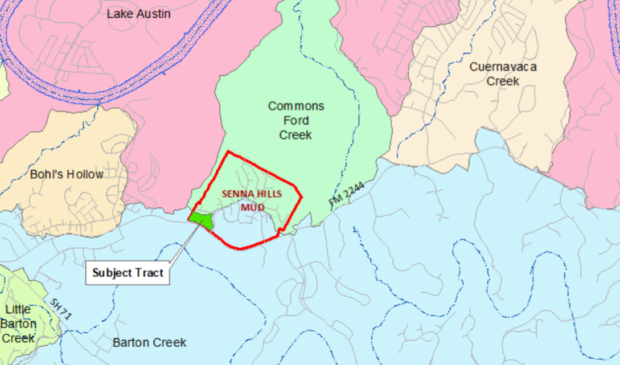Planning Commission OKs change to 30-year-old development agreement
Thursday, January 24, 2019 by
Jack Craver Homes produce a lot less sewage now than they did 30 years ago. That’s partly why the Planning Commission decided Tuesday to allow the construction of an office building in western Travis County over the objections of city staff.
The story begins in 1986, when City Council approved the creation of the Senna Hills Municipal Utility District to oversee a new residential development just north of Bee Caves Road and the Barton Creek Habitat Preserve. The agreement approved by Council laid out specific rules about how the land would be developed, including the amount of open space needed for “wastewater irrigation.”
The land that the developer, Rip Miller, is now targeting for a 180,000-square-foot office building was originally set aside for an elementary school. However, plans for the school were never realized because another school ended up being built nearby. However, the 30-year-old agreement still prohibits any other use for the land.
Representatives for Rip Miller argued that the agreement represented what Council and the developer believed would be needed at the time. Over the past three decades, those needs have clearly changed and the agreement should be changed to reflect that.
The development is producing “considerably less effluent” than anticipated by the 1986 agreement, explained Leah Bojo, an agent for the developer. The project also didn’t include as many dwelling units as envisioned.
“Over the last 30 years, we’ve come to use much more efficient fixtures in bathrooms,” said Bojo. “When you’re building homes in 2018, they don’t produce nearly as much discharge, which is great.”
Most commissioners were sympathetic to the developer’s argument.
Commissioner Fayez Kazi said he was surprised by staff’s “hard stance,” considering that the proposed development wouldn’t violate the environmental standards set forth in the original agreement.
Chris Herrington, the environmental officer for the Watershed Protection Department, said that the language in the agreement was “crystal clear” and that his obligation is to protect open space.
“The permanent protection of open space is the number one priority of the water quality protection mission of the Watershed Protection Department,” he said.
Commissioner Jeffrey Thompson agreed, saying that the language is unambiguous.
Commissioner Conor Kenny said he believed staff members were doing their jobs by enforcing the language of the agreement, but that it was up to the commission to recognize the need for a change.
“I think this is one of those cases that’s exactly why we’re here,” he said. “I think our position is to look at this and say, is it reasonable; what do the stakeholders think?”
Kazi disagreed. Staff also has a responsibility to be flexible and recognize the value of changing the rules when they are no longer serving their purpose, he argued.
“I think part of staff’s role also is to paint the whole picture,” he said.
Commissioner Karen McGraw suggested that approving a new office building in the suburbs conflicted with the stated goals of many of her colleagues to establish walkable, transit-oriented “complete communities.” McGraw is often opposed to dense developments in Central Austin that her colleagues support on those grounds.
Chair James Shieh pushed back, saying that in fact putting office space in the subdivision is very much in line with creating complete communities. Allowing people who live in that area to work there provides an opportunity to decrease traffic coming into the city, he said.
In the end, even McGraw voted to recommend changing the agreement to allow the office building. The final vote was 10-2 in favor, with only Thompson and Commissioner Greg Anderson opposed.
This story has been changed since publication in order to correct a quote. Map courtesy of the city of Austin.
The Austin Monitor’s work is made possible by donations from the community. Though our reporting covers donors from time to time, we are careful to keep business and editorial efforts separate while maintaining transparency. A complete list of donors is available here, and our code of ethics is explained here.
You're a community leader
And we’re honored you look to us for serious, in-depth news. You know a strong community needs local and dedicated watchdog reporting. We’re here for you and that won’t change. Now will you take the powerful next step and support our nonprofit news organization?



